Vikings101: Unveiling Historical and Filming Locations in Ireland’s Landscape

Updated On: April 24, 2024 by Fatma Mohamed
Embarking on a voyage through Ireland’s landscapes and rich history, we unveil the intertwining worlds where the fierce Norse warriors known as Vikings once roamed and where the acclaimed historical drama ‘Vikings’ found its visual canvas. The series, debuting in 2013, immersed viewers in the sagas of legendary Viking chieftains and their exploits, drawing upon the historical context of Vikings in Ireland to bring their tales to life on screen. Our exploration delves into the iconic filming locations peppered across Ireland that served as a backdrop for this gripping narrative, offering an opportunity to step into the realms of history and cinematic craft.
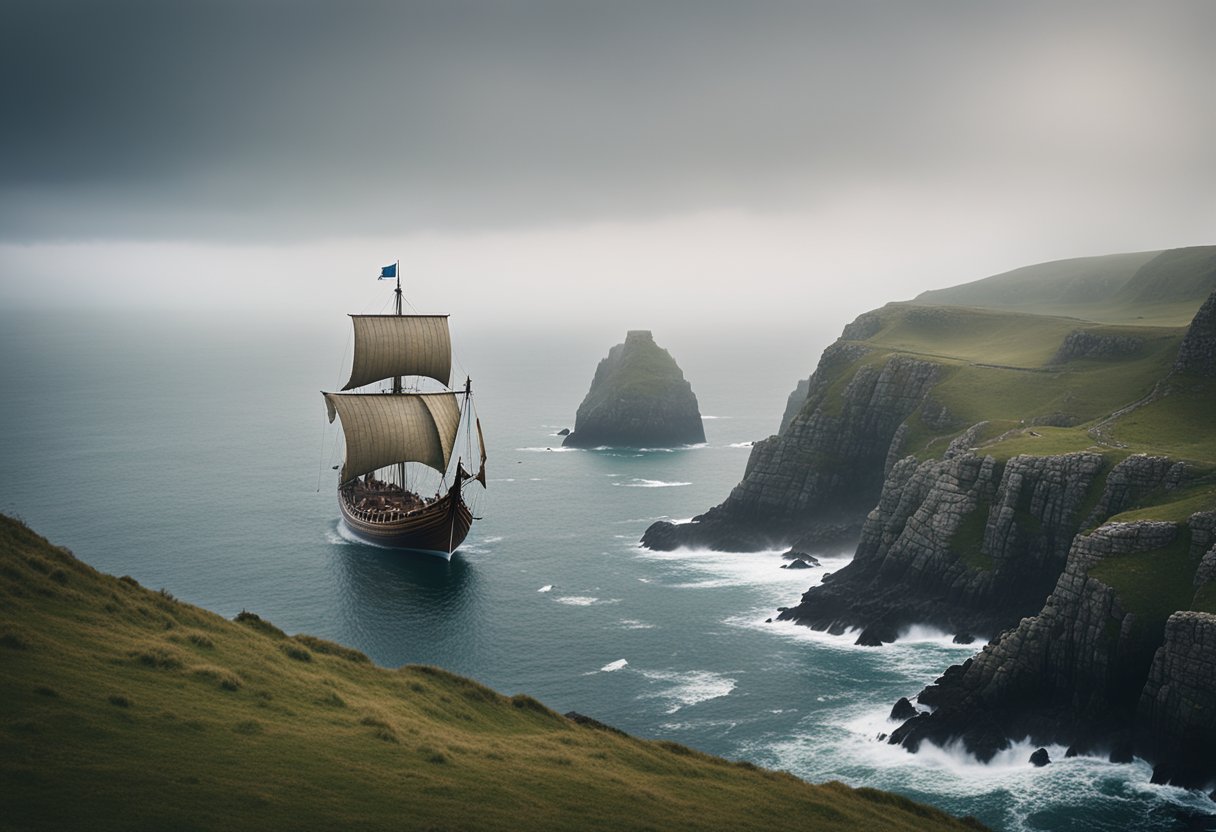
We navigate the terrains where dramatised sieges and conquests unfolded, revealing the geographical marvels and historical sites that form a tangible link to Ireland’s Viking past. These settings not only enhance the storytelling of the Vikings series but also draw us closer to understanding the profound cultural impact and tourism benefits these locations garner. From the Wicklow Mountains to the shores of Lough Tay, these lands whisper the legacy of Viking settlers and their enduring influence on Irish culture, education, and popular imagination.
Following the trails of both the real and reimagined Norse adventurers, we uncover the meticulous craftsmanship involved in selecting and utilising Ireland’s natural and historical heritage as cinematic stagecraft. This journey through Ireland’s Viking sites and filming strongholds extends the legacy of the saga’s cultural phenomenon, prompting us to consider the ways in which these landmarks captivate and educate enthusiasts and travellers alike.
Table of Contents
The Historical Context of Vikings in Ireland
In this section, we uncover the profound impact of Viking incursions and settlements on Ireland and explore the island’s significance in the grand tapestry of Norse sagas.
Viking History and Settlements in Ireland
Ireland was a significant target for Norsemen, known commonly as Vikings, beginning with their initial raid on the monastery of St. Columba on Rathlin Island in 795 CE. These seafaring Scandinavians sought treasures and wealth, often targeting monastic sites which were rich in resources but poorly defended.
Over the years, Vikings settled in Ireland, establishing prominent coastal bases, which later evolved into some of today’s cities, including Dublin as a noteworthy example. Their influence extended beyond mere plundering; it introduced new trade links, cultural exchanges, and even genetic diversity.
Ireland’s Role in Norse Sagas
The sagas – written records of history and mythology – reflect the importance of Ireland in the Norse world. Irish territories and figures often feature in these epic narratives, entwining Viking legend with Irish folklore. From the tales of audacious Norse heroes navigating the Irish Sea to the interactions with Irish kings, the sagas encapsulate a complex relationship that shaped the cultural fabric of both Viking and Irish societies.
Our Viking legacy remains etched into Ireland’s historical landscape, influencing everything from urban developments to captivating storylines in modern portrayals such as those by the History Channel. This complex intertwinement is a testament to the lasting influence of Vikings on the island, an era that continues to capture the imagination and curious minds across the world.
Vikings in Irish Education and Culture
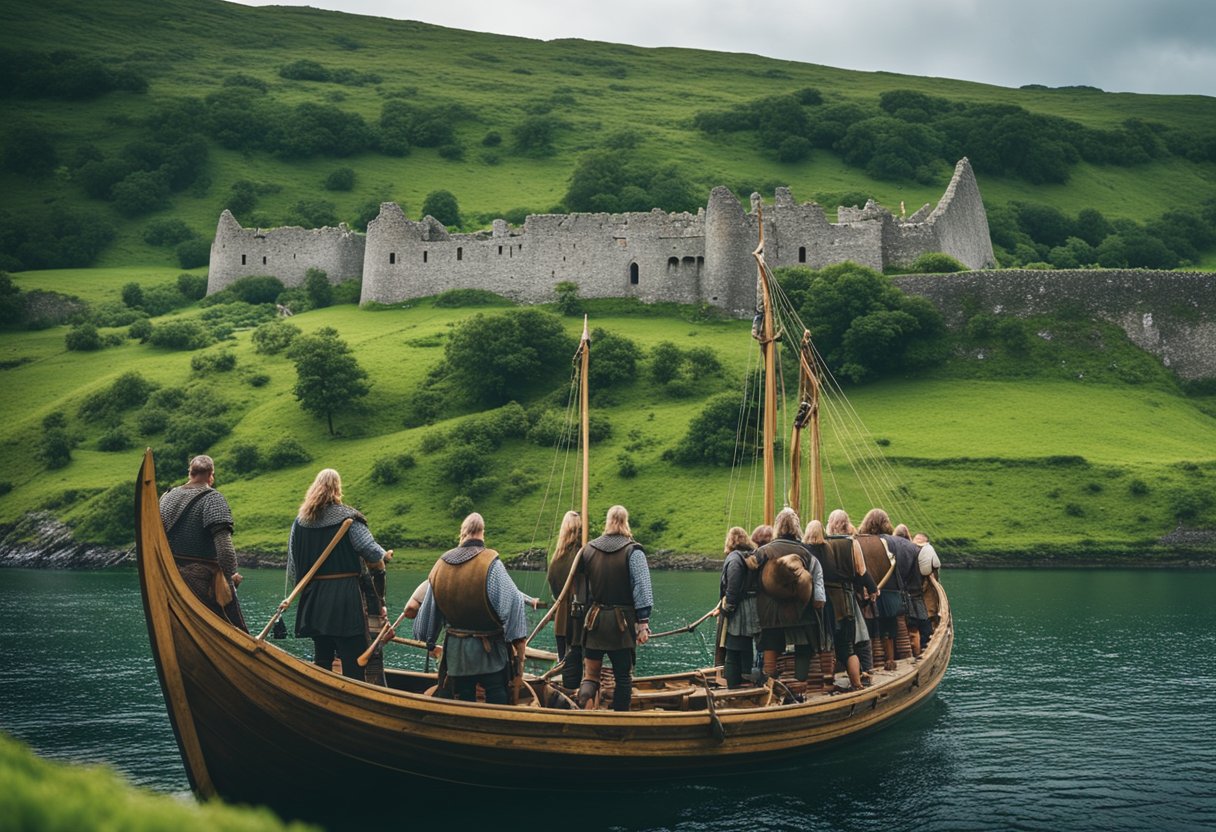
We recognise the significant impact of the Vikings, not just on the Irish landscape but in the realm of education and culture as well. Their influence flavours our understanding of history and extends to engaging exhibits and festivals.
Dublinia: The Viking and Medieval Dublin Museum
Dublinia is a pivotal institution that provides a deep dive into Ireland’s Viking and medieval past. It stands as a testament to the Norsemen‘s integration into Irish culture. Visitors are enlivened by interactive exhibits, where the rich tapestry of Dublin’s history is woven together, showcasing how the Norse settlers became an integral part of our heritage.
Annual Events: Viking Festivals in Ireland
We look forward to the Dublinia Viking Festival, an event that brings history to life against the backdrop of the sweeping Irish landscape. This annual celebration is a vivid reenactment and a gathering that offers a glimpse into the life of the Vikings through crafts, combat demonstrations, and traditional Norse storytelling. While this festival energises the local community, it also attracts visitors from far and wide, eager to experience the vibrancy of Viking culture.
Iconic Filming Locations of Vikings
Ireland’s lush landscapes and historic sites have been immortalised through the adventures of the hit series Vikings. From the imitation of Norse territories to the ancient lands of England, the series celebrated Ireland’s natural beauty and its capacity to transport viewers to another time.
Ashford Studios: The Epicentre of Production
Ashford Studios is the heart where Vikings breathed to life, functioning as a hub for the show’s production from its first season. With state-of-the-art facilities, the studio in County Wicklow enabled the producers to construct elaborate sets that authentically represented Viking villages like Kattegat.
Wicklow: The Scenic Heart of Vikings
The enchanting Wicklow Mountains play a starring role, providing a dramatic backdrop to several key scenes. Lough Tay, commonly referred to as Guinness Lake, featured as the picturesque yet formidable landscape surrounding Kattegat—the Vikings’ central hub. The nearby Luggala Estate has also graced the screen, offering unrivalled natural beauty that captivates audiences and reinforces the raw, untamed essence of the era depicted.
Northern Ireland: A Glimpse into the Northumbrian Scenes
Venturing into Northern Ireland, viewers are given a glimpse of Vikings’ depiction of Northumbria. The rugged terrains and historic ruins lend themselves to creating atmospheric scenes filled with political intrigue and conflict, as they provide striking contrasts and diversity to the Irish locales, enriching the visual fabric of the series.
Our exploration of Viking’s filming locations unravels the spell-binding sceneries Ireland offers, highlighting Wicklow County’s prominence, from the majestically flowing Powerscourt Waterfall to the secluded monastic settlements evoked within the show. Fans of the Netflix series and those with a keen eye will recognise these iconic spots, each steeped in cinematic legacy and natural allure.
Geographic Marvels as Seen on Vikings
In this section, we explore the stunning natural backdrops of Ireland that served as key filming locations for the popular series Vikings. The raw beauty of these sites not only brought to life the Viking world but has also captured the hearts of viewers.
Lough Tay: The Real Kattegat
Lough Tay, in County Wicklow, Ireland, is one such location where its serene waters and surrounding landscapes represent Kattegat Village in the series. Often referred to as the ‘Guinness Lake’ due to its dark waters and the white sandy beach at its northern end resembling a pint of the famous stout, Lough Tay has become synonymous with the home of the Vikings. The nearby Viking house and Kattegat village used in the series are not just sets but a testament to Ireland’s capacity to encapsulate historical authenticity through its geography.
Powerscourt Waterfall: Depicting the Majesty of Norse Landscapes
Further showcasing Ireland’s contribution to the Norse saga is Powerscourt Waterfall, Ireland’s highest waterfall and a sight of incredible natural beauty. Nestled in the foothills of the Wicklow Mountains, the waterfall and its lush surroundings have been depicted in Vikings, offering a glimpse into the majestic and rugged landscapes associated with Norse mythology. The use of CGI is minimal as the splendour of Powerscourt Waterfall needs little enhancement to convey the might and spirit of the Viking era.
The Craft of Filming Locations
In our exploration of epic series like Vikings, the selection and craft of filming locations play pivotal roles in the authenticity and immersion of the audience. A meticulous blend of green screen technology and real-world landscapes come together to create the compelling historical world that fans adore.
Green Screen and CGI Enhancements
The use of green screen technology in Vikings allows us to transport actors to virtually any environment. This technology, coupled with Computer Generated Imagery (CGI), magnifies visual storytelling by digitally crafting intricate backdrops that would be otherwise impossible or impractical to recreate physically. Ashford Studios, located in County Wicklow, Ireland, serves as a central hub where much of this green screen magic takes place, bringing to life the vast and rugged landscapes of the Viking era.
Real Locations vs. Set Designs
Contrasting with CGI, the physical filming locations in Ireland provide Vikings with its rich and authentic atmospheres. The lush valleys and rugged mountains of Wicklow themselves are undisguised stars of the show, offering real-world vistas that grind the story into a tangible reality. This harmonious balance between actual locations and elaborate set designs at Ashford Studios ensures that the historical realm depicted in Vikings retains its gripping believability. By choosing to film in actual Irish landscapes, we honour both the historical authenticity that fans expect and Ireland’s natural beauty.
Cultural Impact and Tourism
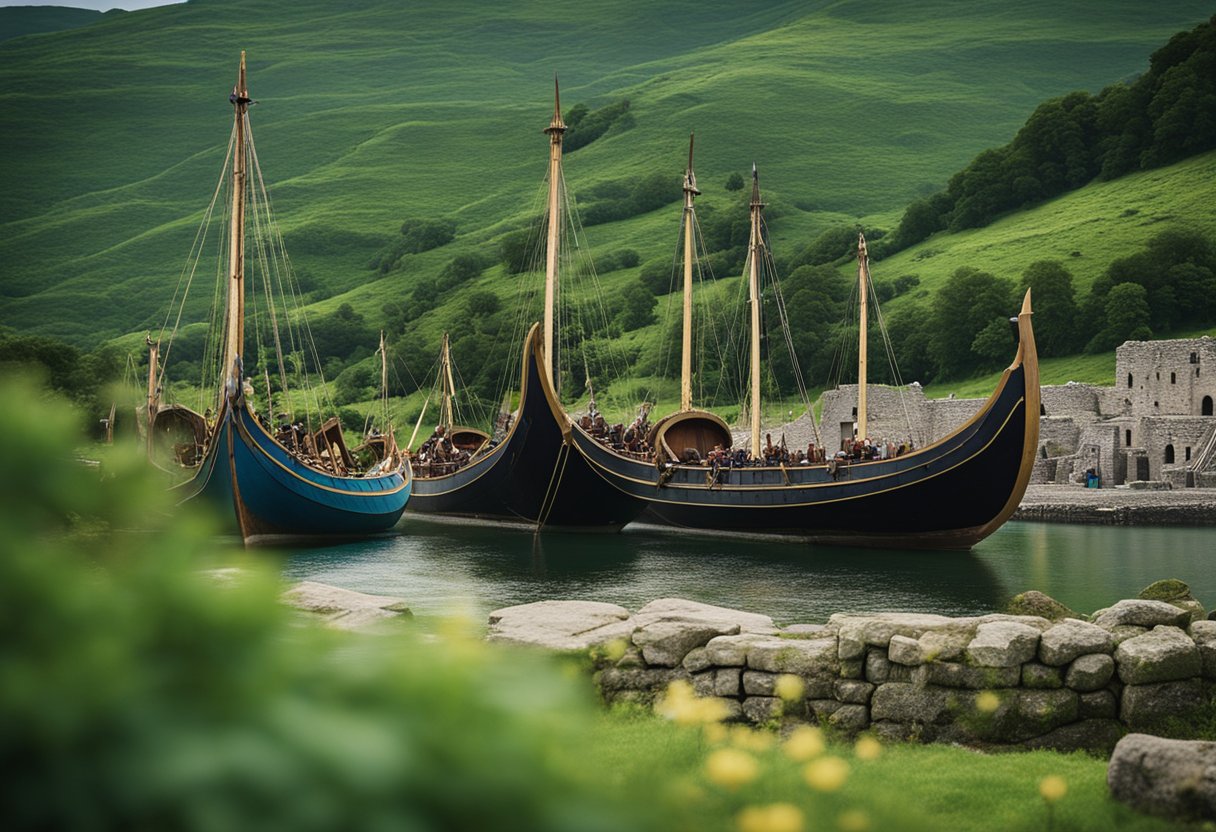
As the epic tale of Vikings unfolded on screens worldwide, Ireland’s rugged landscapes and historical sites gained international recognition. This section explores how the series has fuelled an increased interest in these Irish locales, transforming them into must-visit destinations for fans and history buffs alike.
How Vikings Have Shaped Irish Tourism
The sweeping success of Vikings has significantly boosted tourism in Ireland. Wicklow dubbed the “Garden of Ireland,” has seen a surge in visitors thanks to its transformation into the fictional town of Kattegat on screen. Historical re-enactments and a Viking Festival bring the past to life, featuring Viking longships and captivating storytelling. The Viking influence extends beyond entertainment, infusing a new vigour into Ireland’s tourism narrative.
Tourists are drawn not only to the beauty of the Wicklow Way but to the entire scope of the Wild Atlantic Way, which presents a vista of Ireland’s untamed coastlines. At these sites, visitors encounter a combination of serene Irish landscapes and the fascinating legacy of the Vikings.
Visiting the Locations: A Guide for Fans
For enthusiasts eager to tread the paths of their favourite Vikings characters, a visit to the Wicklow Mountains is essential. Here, among the Blessington Lakes and Nun’s Beach, the otherworldly beauty of Ireland’s nature becomes apparent.
- River Boyne – unearth the region’s rich history by kayaking down the same waters where Viking longships once sailed.
- Kerry – roam the picturesque scenery that has captivated audiences, reinforcing the show’s popularity.
The impact of Vikings on local tourism is clear: fans and travellers are increasingly eager to immerse themselves in Ireland, which provided the backdrop for the Viking sagas – an Ireland that remains as captivating as ever.
Historical Sites and Viking Connection
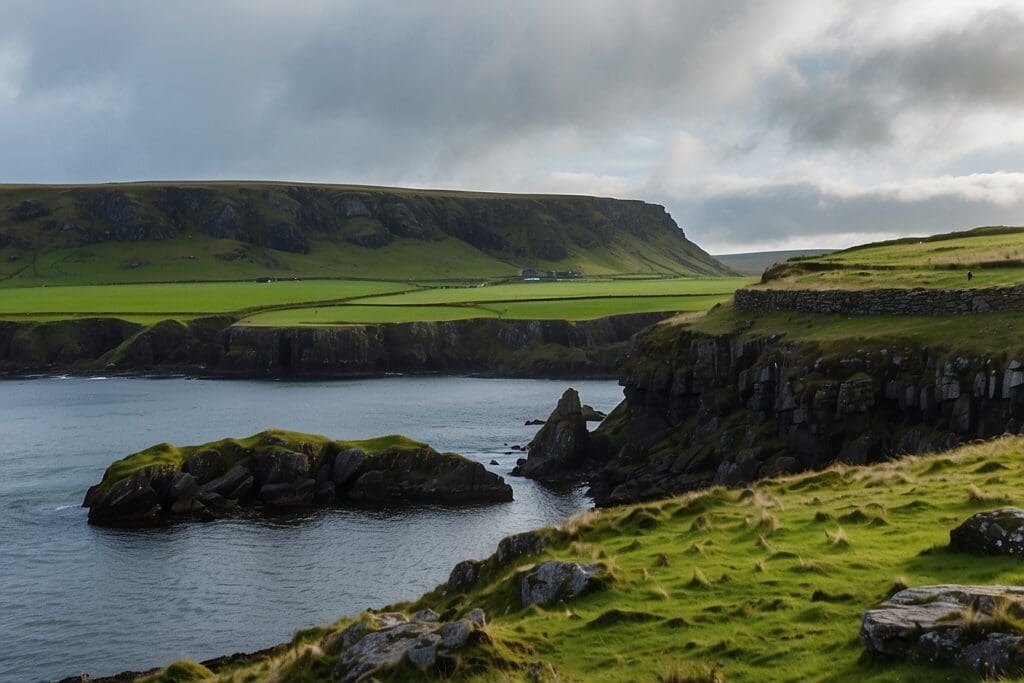
Ireland’s landscape is dotted with historical sites that bear the marks of various civilizations, including the Vikings, whose presence stretched as far as the Emerald Isle from their homelands in Scandinavia. In particular, County Meath and County Kerry offer distinct narratives of the Norse legacy, with sites that provide a deeper understanding of the Viking impact on Irish history.
County Meath: From the Hill of Tara to Trim Castle
In the heart of the Boyne Valley, County Meath boasts significant landmarks which once echoed the footsteps of both Celtic kings and Norse warriors. The Hill of Tara, once the seat of the High Kings of Ireland, offers panoramic views of Meath, a place where one can feel the pulse of Ireland’s regal past—and its untold stories with Norse visitors. While not directly linked to the Vikings, its importance as a power centre in ancient Ireland indicates likely contact.
Not far from Tara lies Trim Castle, the largest Norman castle in Ireland. Built by Hugh de Lacy in the 12th century, this imposing fortress stands as a witness to the turbulent times when the Vikings roamed Ireland’s waterways. Its stone walls, which have withstood both time and siege, remind us of the constant struggle for dominance in medieval Ireland, including the influence of powerful Norse-Gael lords in regions like Northumbria and the broader Scandinavian impact on Irish architecture and urban planning.
County Kerry’s Untouched Norse Connections
Venturing to the rugged landscapes of County Kerry, one discovers less overt but no less significant traces of the Norsemen. This remote region harbours tranquil sites infused with the essence of bygone eras. The Vikings left a more subtle imprint here, primarily through maritime activities. As seafaring traders and explorers, the Vikings engaged with Irish coastal communities, leaving behind cultural echoes and a tangible legacy of Norse-Irish relations that helped shape the Kerry coast.
Kerry’s historical narrative intertwines with the broader Viking expansion from Norway and Scandinavia. Although the physical remnants may not be as pronounced as in Meath, the oral histories and local lore reflect an enduring Viking presence that shaped the cultural tapestry of the region. The influence of the Vikings on Ireland’s coastal settlements is an integral part of our shared heritage, silently encapsulated in Kerry’s landscape.
Influence on Popular Culture
The Vikings series has transcended its origins as a historical drama to become a cultural phenomenon akin to the impact of Game of Thrones. Both have garnered massive followings and have influenced a wide array of media.
Global Reach of Vikings Series
The Vikings TV series, a Canadian-Irish production, first premiered on the History Channel and has since become available on Netflix, broadening its audience significantly. The show’s compelling narrative, backed by strong performances and high production values, has captivated viewers worldwide. This global appeal is evidence of the fascinating allure that the historical drama has on audiences, resonating with fans across diverse cultures who tune in to witness the epic saga of Ragnar Lothbrok and his descendants.
Comparative Analysis: Vikings and Game of Thrones
In comparing the Vikings series with Game of Thrones, we see a range of similarities and differences. Both are lush, epic sagas that bring a bygone era to life, but Vikings offer a more grounded representation, closely based on historical events and figures. Game of Thrones, by contrast, delves into fantasy with its dragons and magic. Nevertheless, both have had significant cultural impacts, sparking discussions among TV series executives and filmmakers about the success of historical and fantasy dramas. The popularity of these series has prompted a renaissance of the genres, solidifying their place in popular culture.
Behind the Scenes
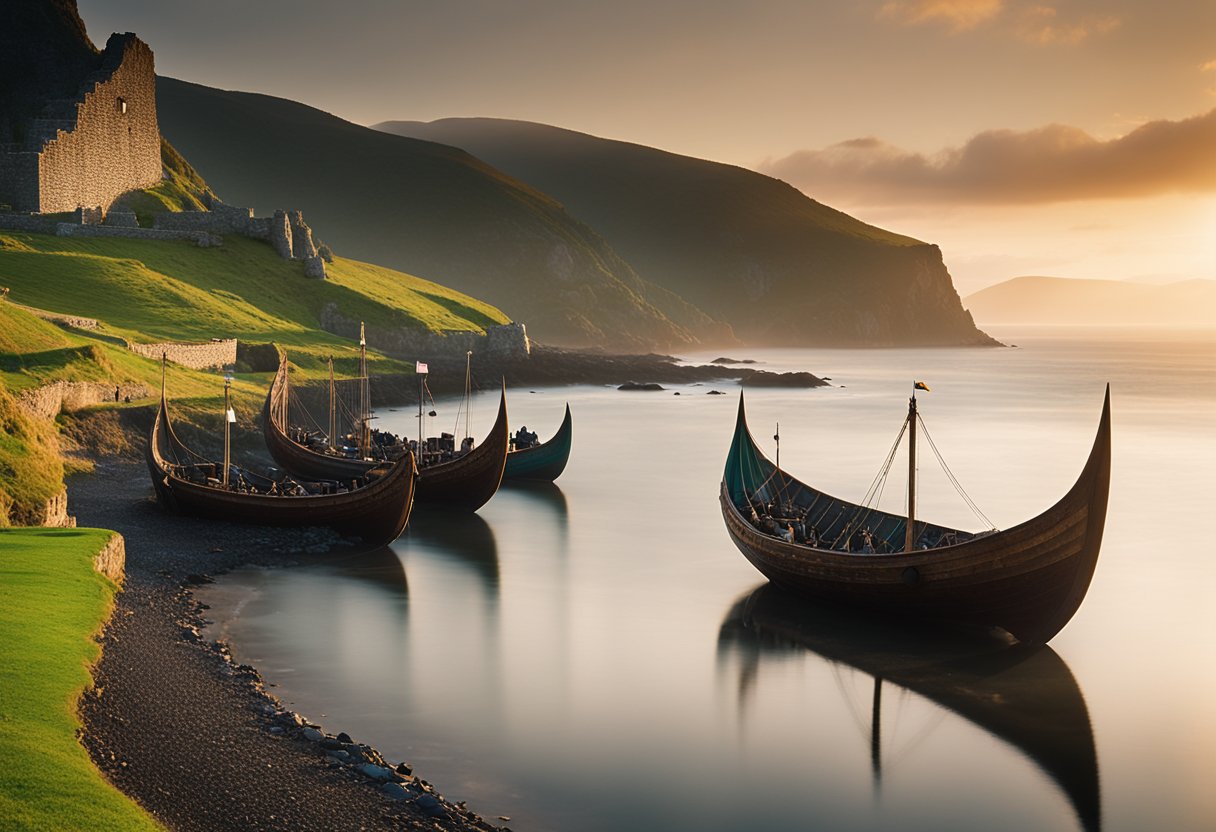
We delve into the meticulous production processes and the dynamic challenges that come with filming in Ireland, providing a closer look at the creation of the “Vikings” TV series.
Production Insights from Ashford Studios
At the heart of Vikings lies the Ashford Studios, a renowned filming hub in Ireland’s Wicklow County. This state-of-the-art facility has been pivotal in bringing Michael Hirst’s vision to life, where producers and filmmakers, under his guidance, have crafted the compelling narrative of the Norse sagas. It’s here that the authenticity of sets, meticulous attention to historical detail, and the raw emotions of performances coalesce to create the immersive world of the Vikings.
Challenges and Triumphs of Filming in Ireland
Filming in Ireland’s rugged landscapes is not without its trials. However, the filming locations across Ireland, with their natural beauty and historical resonance, provide a fitting and dramatic backdrop for the series, resonating with the saga’s spirit. From the windswept valleys that depict the fjords of Kattegat to the icy expanses used for the show’s formidable expeditions, Ireland’s diverse scenery has been instrumental in the narrative. These locations, while challenging due to weather and accessibility, have ultimately triumphed in adding unparalleled depth and realism to the visual storytelling of Vikings.
Extending the Legacy
Vikings have left an indelible mark on the history and culture of Ireland, and we see this legacy continued through various educational programmes that draw inspiration from their lore and historical impact.
Educational Programmes Inspired by Vikings
Ireland has become a hub for Viking enthusiasts and scholars, with parks and educational centres conducting programmes that embellish the rich tapestry of Viking history. Participants are offered a chance to step back in time and learn about iconic figures like Ragnar Lothbrok, his wife Aslaug, and their son Ubbe, with storytelling that weaves factual history with legendary accounts.
Workshops and Exhibitions:
- Hands-on workshops engage visitors in the crafting techniques, such as metalwork and shipbuilding, that were essential to Viking life.
- Interactive exhibitions illustrate the Vikings’ journeys, trade routes, and settlements, especially highlighting the Norse legacy in Ireland.
Interactive Parks:
- Thematic parks recreate the Viking Age with meticulous attention to detail, offering immersive experiences.
- Guides and re-enactors often portray figures such as Ragnar Lodbrok, bringing legendary stories to life amidst authentic settings.
Frequently Asked Questions
In this section, we answer some of the most common questions about the ‘Viking’ series and its connection to Ireland, providing insights into filming locations and historical sites.
Which locations in Ireland served as the backdrop for the ‘Vikings series?
Ireland’s picturesque landscapes were the primary setting for the ‘Vikings’ series, with County Wicklow’s lush terrain prominently featured as the backdrop for many scenes. Sites like the Blessington Lakes and the rugged Irish Sea coastline offered an authentic feel of the Norse era.
What are the primary historical sites featured in the ‘Vikings’ television show?
The “Vikings” series showcases several historical sites across Ireland, including ancient monasteries and ruins that reflect Ireland’s rich cultural heritage. Monastic settlements such as those found at Glendalough were used to depict the spiritual and communal life during the Viking Age.
Can you list the Irish castles used during the filming of ‘Vikings’?
Ashford Castle and Lough Cutra Castle are among the majestic Irish castles that hosted the production of ‘Vikings. Their medieval architecture provided the perfect setting for some of the series’ most dramatic moments.
In which Irish counties were the majority of ‘Vikings’ scenes shot?
The majority of ‘Vikings’ scenes were shot in the counties of Wicklow, Dublin, and Meath. Wicklow, often referred to as the “Garden of Ireland”, was particularly significant due to its diverse and scenic landscape.
How were the pivotal Viking settlement sites chosen for the series in Ireland?
The pivotal Viking settlement sites for the series were chosen for their authentic landscapes and historical significance. Locations were selected for their ability to recreate the atmosphere of the Viking Age and their resemblance to the Scandinavian topography.
Is the village of Kattegat a real place, and where in Ireland was it filmed?
The village of Kattegat from the Vikings series is not a real place but a fictional representation of a Viking settlement. The scenes depicting Kattegat were primarily filmed at Lough Tay in County Wicklow, where the natural fjord-like appearance complemented the show’s setting.






